Goal Setting and Planning: Strategies for Business Development Success
VerifiedAdded on 2021/06/14
|12
|4248
|24
Report
AI Summary
This report examines the critical role of goal setting and planning in business development. It emphasizes the importance of establishing clear objectives and outlines the benefits of well-defined goals, such as increased focus and improved performance. The report delves into the landmark study by Miles & Vergen, highlighting their conditions for effective goal setting and their insights on adapting to environmental changes. It also introduces the concept of Management by Objectives (MBO), a methodology that aligns managerial and team goals to achieve desired outcomes within specified timeframes. Furthermore, the report discusses various types of plans, including strategic, tactical, and operational plans, and explores the contingency factors that influence a manager's approach to planning. The document emphasizes the importance of setting up SMART goals and using feedback to improve the efficiency of an organization and overall business success.
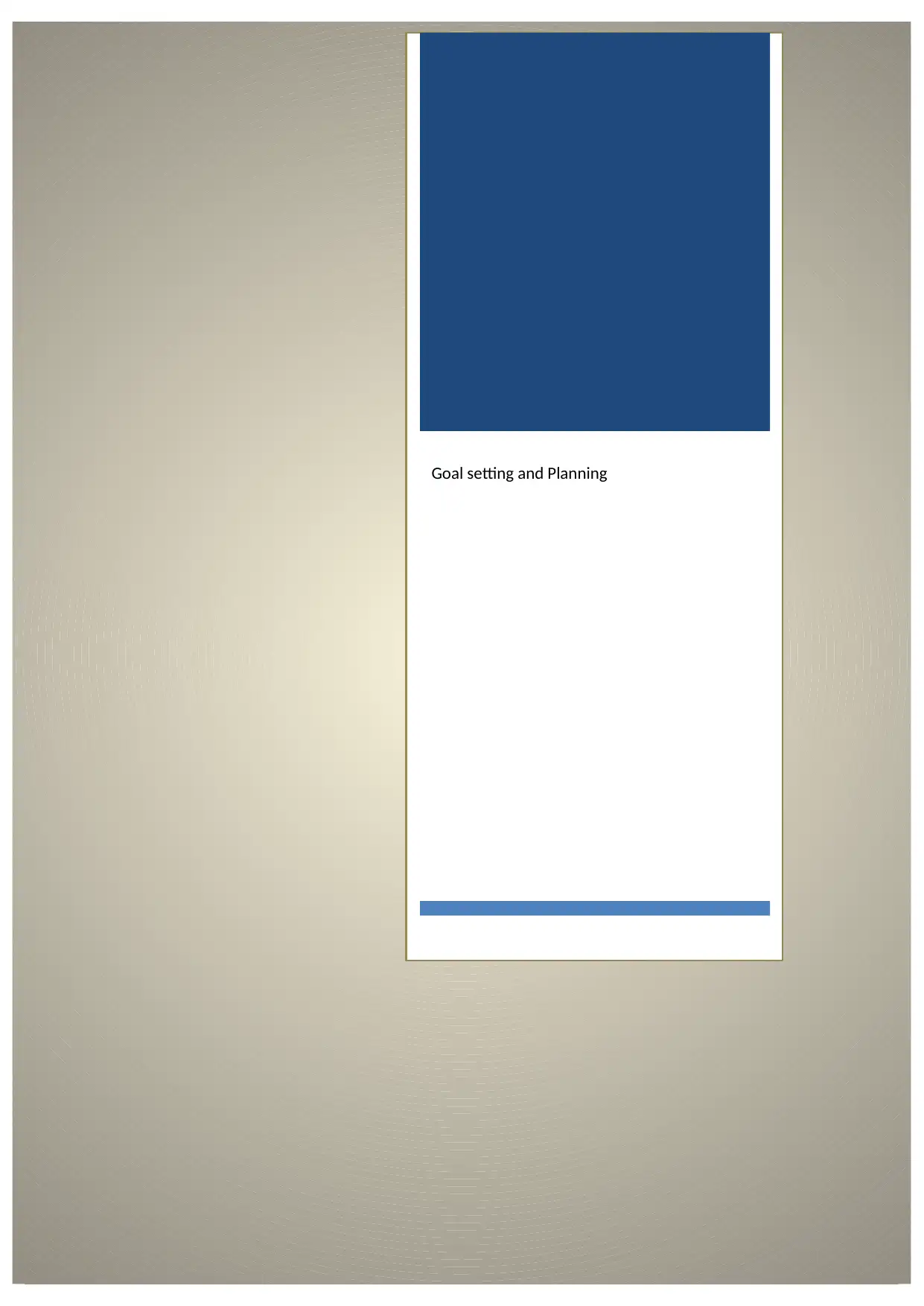
Goal setting and Planning
Paraphrase This Document
Need a fresh take? Get an instant paraphrase of this document with our AI Paraphraser

1 | P a g e G o a l s e tti n g a n d p l a n n i n g

2 | P a g e G o a l s e tti n g a n d p l a n n i n g
Executive Summary
The below report focuses on importance of goals and planning in a business. Setting
up goals also helps in managing the tasks to improve the productivity. The importance of
setting up the goals and then working upon it are turned to be more efficient. Miles study on
goal planning and settling has also been highlighted along with their conditions of working.
The management of objective approach has also been discussed and how it is important in a
business. The core concept of using management by objectives helps an organisation to react
to all the events and problems rather than is being proactive. The type of plans that are used
while working in a business has been discussed.
Executive Summary
The below report focuses on importance of goals and planning in a business. Setting
up goals also helps in managing the tasks to improve the productivity. The importance of
setting up the goals and then working upon it are turned to be more efficient. Miles study on
goal planning and settling has also been highlighted along with their conditions of working.
The management of objective approach has also been discussed and how it is important in a
business. The core concept of using management by objectives helps an organisation to react
to all the events and problems rather than is being proactive. The type of plans that are used
while working in a business has been discussed.
⊘ This is a preview!⊘
Do you want full access?
Subscribe today to unlock all pages.

Trusted by 1+ million students worldwide
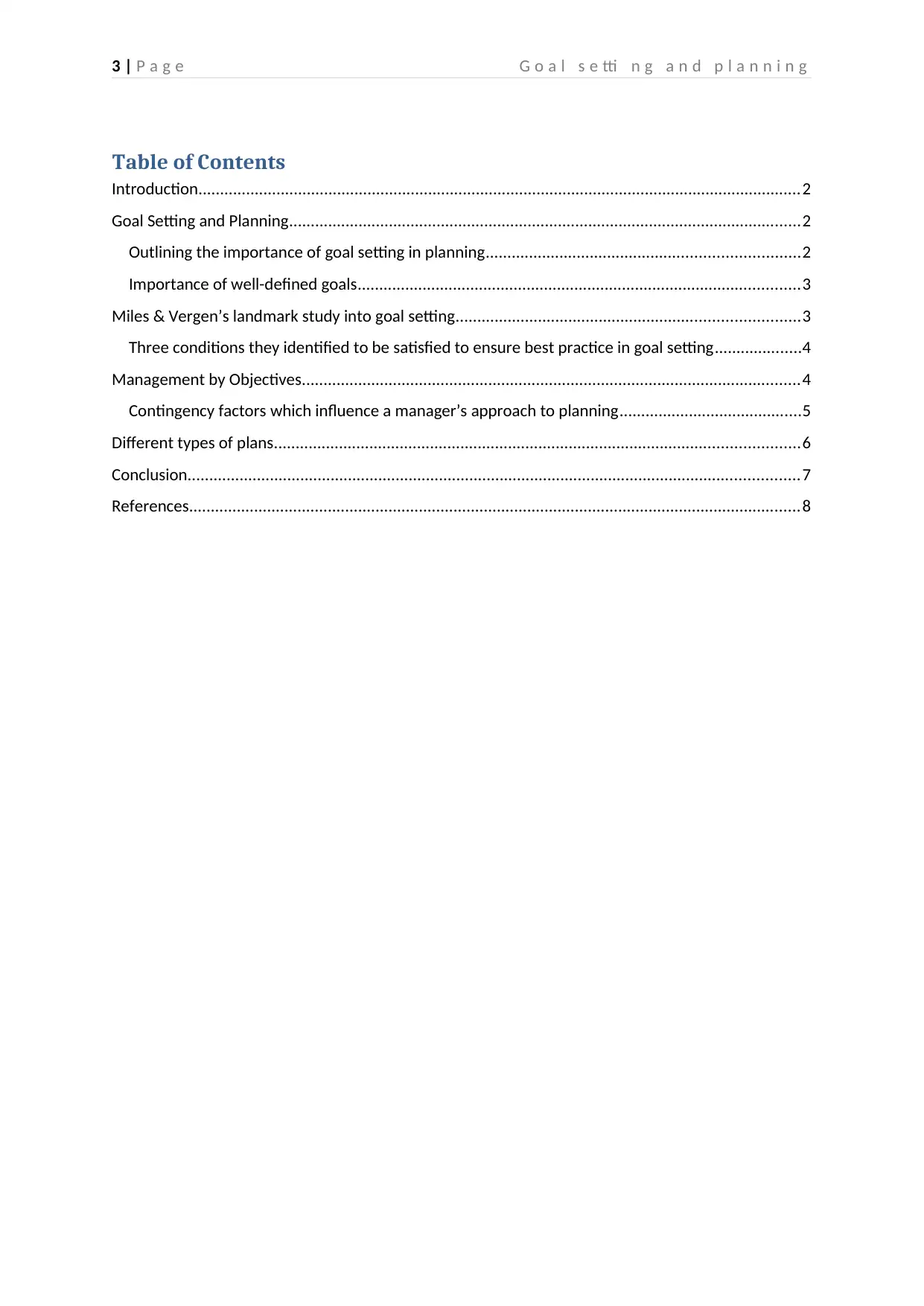
3 | P a g e G o a l s e tti n g a n d p l a n n i n g
Table of Contents
Introduction...........................................................................................................................................2
Goal Setting and Planning......................................................................................................................2
Outlining the importance of goal setting in planning........................................................................2
Importance of well-defined goals......................................................................................................3
Miles & Vergen’s landmark study into goal setting...............................................................................3
Three conditions they identified to be satisfied to ensure best practice in goal setting....................4
Management by Objectives...................................................................................................................4
Contingency factors which influence a manager’s approach to planning..........................................5
Different types of plans.........................................................................................................................6
Conclusion.............................................................................................................................................7
References.............................................................................................................................................8
Table of Contents
Introduction...........................................................................................................................................2
Goal Setting and Planning......................................................................................................................2
Outlining the importance of goal setting in planning........................................................................2
Importance of well-defined goals......................................................................................................3
Miles & Vergen’s landmark study into goal setting...............................................................................3
Three conditions they identified to be satisfied to ensure best practice in goal setting....................4
Management by Objectives...................................................................................................................4
Contingency factors which influence a manager’s approach to planning..........................................5
Different types of plans.........................................................................................................................6
Conclusion.............................................................................................................................................7
References.............................................................................................................................................8
Paraphrase This Document
Need a fresh take? Get an instant paraphrase of this document with our AI Paraphraser
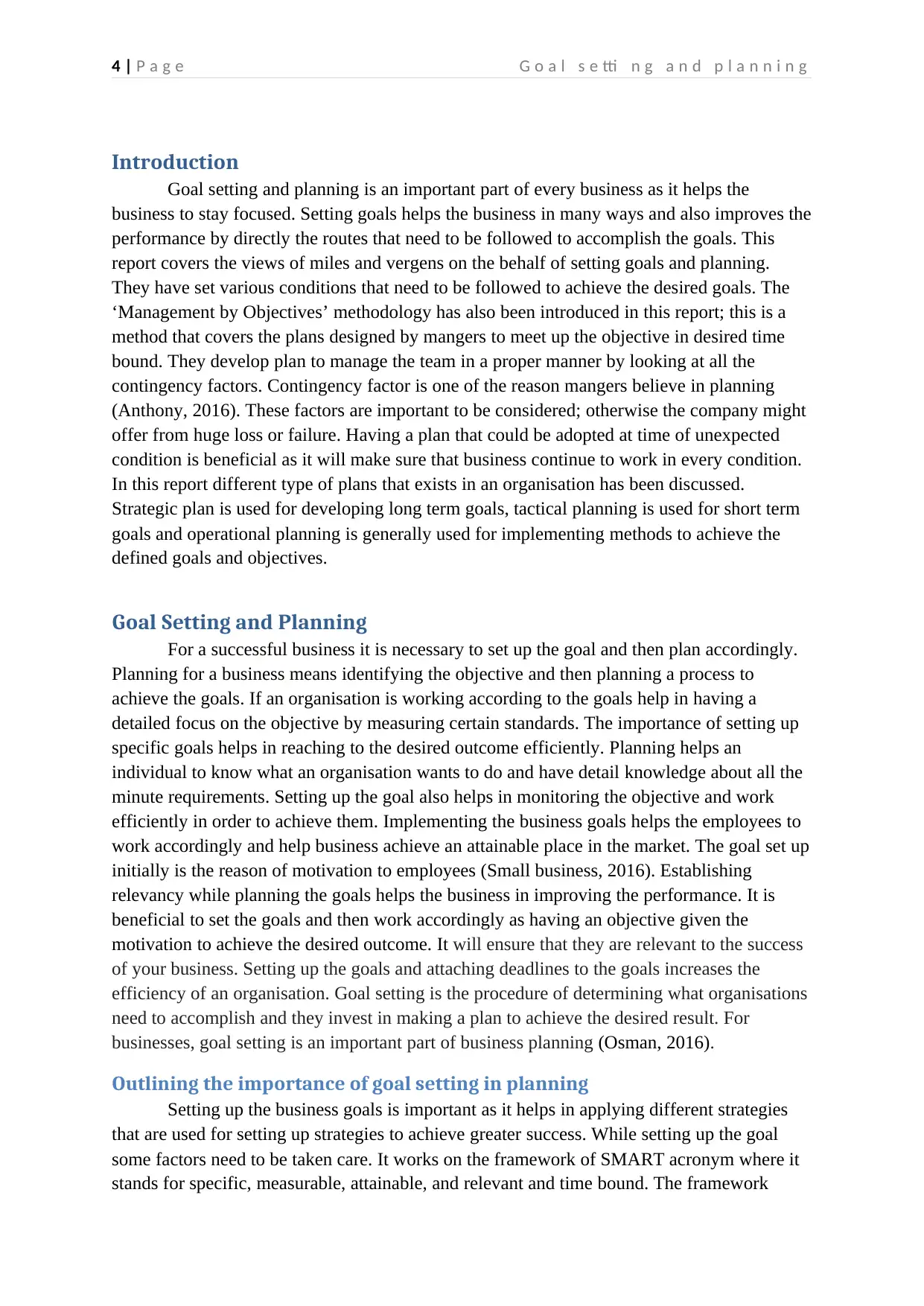
4 | P a g e G o a l s e tti n g a n d p l a n n i n g
Introduction
Goal setting and planning is an important part of every business as it helps the
business to stay focused. Setting goals helps the business in many ways and also improves the
performance by directly the routes that need to be followed to accomplish the goals. This
report covers the views of miles and vergens on the behalf of setting goals and planning.
They have set various conditions that need to be followed to achieve the desired goals. The
‘Management by Objectives’ methodology has also been introduced in this report; this is a
method that covers the plans designed by mangers to meet up the objective in desired time
bound. They develop plan to manage the team in a proper manner by looking at all the
contingency factors. Contingency factor is one of the reason mangers believe in planning
(Anthony, 2016). These factors are important to be considered; otherwise the company might
offer from huge loss or failure. Having a plan that could be adopted at time of unexpected
condition is beneficial as it will make sure that business continue to work in every condition.
In this report different type of plans that exists in an organisation has been discussed.
Strategic plan is used for developing long term goals, tactical planning is used for short term
goals and operational planning is generally used for implementing methods to achieve the
defined goals and objectives.
Goal Setting and Planning
For a successful business it is necessary to set up the goal and then plan accordingly.
Planning for a business means identifying the objective and then planning a process to
achieve the goals. If an organisation is working according to the goals help in having a
detailed focus on the objective by measuring certain standards. The importance of setting up
specific goals helps in reaching to the desired outcome efficiently. Planning helps an
individual to know what an organisation wants to do and have detail knowledge about all the
minute requirements. Setting up the goal also helps in monitoring the objective and work
efficiently in order to achieve them. Implementing the business goals helps the employees to
work accordingly and help business achieve an attainable place in the market. The goal set up
initially is the reason of motivation to employees (Small business, 2016). Establishing
relevancy while planning the goals helps the business in improving the performance. It is
beneficial to set the goals and then work accordingly as having an objective given the
motivation to achieve the desired outcome. It will ensure that they are relevant to the success
of your business. Setting up the goals and attaching deadlines to the goals increases the
efficiency of an organisation. Goal setting is the procedure of determining what organisations
need to accomplish and they invest in making a plan to achieve the desired result. For
businesses, goal setting is an important part of business planning (Osman, 2016).
Outlining the importance of goal setting in planning
Setting up the business goals is important as it helps in applying different strategies
that are used for setting up strategies to achieve greater success. While setting up the goal
some factors need to be taken care. It works on the framework of SMART acronym where it
stands for specific, measurable, attainable, and relevant and time bound. The framework
Introduction
Goal setting and planning is an important part of every business as it helps the
business to stay focused. Setting goals helps the business in many ways and also improves the
performance by directly the routes that need to be followed to accomplish the goals. This
report covers the views of miles and vergens on the behalf of setting goals and planning.
They have set various conditions that need to be followed to achieve the desired goals. The
‘Management by Objectives’ methodology has also been introduced in this report; this is a
method that covers the plans designed by mangers to meet up the objective in desired time
bound. They develop plan to manage the team in a proper manner by looking at all the
contingency factors. Contingency factor is one of the reason mangers believe in planning
(Anthony, 2016). These factors are important to be considered; otherwise the company might
offer from huge loss or failure. Having a plan that could be adopted at time of unexpected
condition is beneficial as it will make sure that business continue to work in every condition.
In this report different type of plans that exists in an organisation has been discussed.
Strategic plan is used for developing long term goals, tactical planning is used for short term
goals and operational planning is generally used for implementing methods to achieve the
defined goals and objectives.
Goal Setting and Planning
For a successful business it is necessary to set up the goal and then plan accordingly.
Planning for a business means identifying the objective and then planning a process to
achieve the goals. If an organisation is working according to the goals help in having a
detailed focus on the objective by measuring certain standards. The importance of setting up
specific goals helps in reaching to the desired outcome efficiently. Planning helps an
individual to know what an organisation wants to do and have detail knowledge about all the
minute requirements. Setting up the goal also helps in monitoring the objective and work
efficiently in order to achieve them. Implementing the business goals helps the employees to
work accordingly and help business achieve an attainable place in the market. The goal set up
initially is the reason of motivation to employees (Small business, 2016). Establishing
relevancy while planning the goals helps the business in improving the performance. It is
beneficial to set the goals and then work accordingly as having an objective given the
motivation to achieve the desired outcome. It will ensure that they are relevant to the success
of your business. Setting up the goals and attaching deadlines to the goals increases the
efficiency of an organisation. Goal setting is the procedure of determining what organisations
need to accomplish and they invest in making a plan to achieve the desired result. For
businesses, goal setting is an important part of business planning (Osman, 2016).
Outlining the importance of goal setting in planning
Setting up the business goals is important as it helps in applying different strategies
that are used for setting up strategies to achieve greater success. While setting up the goal
some factors need to be taken care. It works on the framework of SMART acronym where it
stands for specific, measurable, attainable, and relevant and time bound. The framework
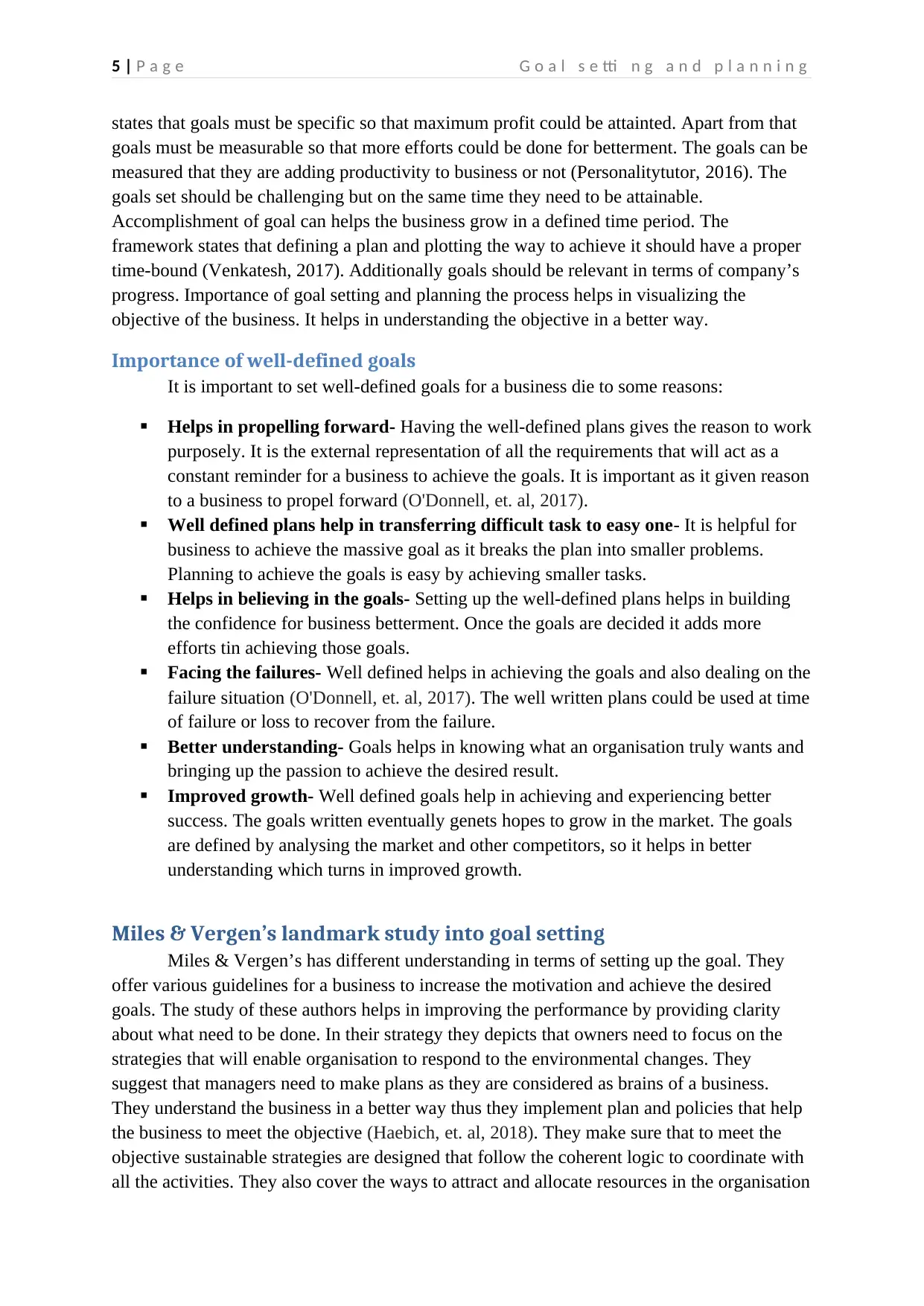
5 | P a g e G o a l s e tti n g a n d p l a n n i n g
states that goals must be specific so that maximum profit could be attainted. Apart from that
goals must be measurable so that more efforts could be done for betterment. The goals can be
measured that they are adding productivity to business or not (Personalitytutor, 2016). The
goals set should be challenging but on the same time they need to be attainable.
Accomplishment of goal can helps the business grow in a defined time period. The
framework states that defining a plan and plotting the way to achieve it should have a proper
time-bound (Venkatesh, 2017). Additionally goals should be relevant in terms of company’s
progress. Importance of goal setting and planning the process helps in visualizing the
objective of the business. It helps in understanding the objective in a better way.
Importance of well-defined goals
It is important to set well-defined goals for a business die to some reasons:
Helps in propelling forward- Having the well-defined plans gives the reason to work
purposely. It is the external representation of all the requirements that will act as a
constant reminder for a business to achieve the goals. It is important as it given reason
to a business to propel forward (O'Donnell, et. al, 2017).
Well defined plans help in transferring difficult task to easy one- It is helpful for
business to achieve the massive goal as it breaks the plan into smaller problems.
Planning to achieve the goals is easy by achieving smaller tasks.
Helps in believing in the goals- Setting up the well-defined plans helps in building
the confidence for business betterment. Once the goals are decided it adds more
efforts tin achieving those goals.
Facing the failures- Well defined helps in achieving the goals and also dealing on the
failure situation (O'Donnell, et. al, 2017). The well written plans could be used at time
of failure or loss to recover from the failure.
Better understanding- Goals helps in knowing what an organisation truly wants and
bringing up the passion to achieve the desired result.
Improved growth- Well defined goals help in achieving and experiencing better
success. The goals written eventually genets hopes to grow in the market. The goals
are defined by analysing the market and other competitors, so it helps in better
understanding which turns in improved growth.
Miles & Vergen’s landmark study into goal setting
Miles & Vergen’s has different understanding in terms of setting up the goal. They
offer various guidelines for a business to increase the motivation and achieve the desired
goals. The study of these authors helps in improving the performance by providing clarity
about what need to be done. In their strategy they depicts that owners need to focus on the
strategies that will enable organisation to respond to the environmental changes. They
suggest that managers need to make plans as they are considered as brains of a business.
They understand the business in a better way thus they implement plan and policies that help
the business to meet the objective (Haebich, et. al, 2018). They make sure that to meet the
objective sustainable strategies are designed that follow the coherent logic to coordinate with
all the activities. They also cover the ways to attract and allocate resources in the organisation
states that goals must be specific so that maximum profit could be attainted. Apart from that
goals must be measurable so that more efforts could be done for betterment. The goals can be
measured that they are adding productivity to business or not (Personalitytutor, 2016). The
goals set should be challenging but on the same time they need to be attainable.
Accomplishment of goal can helps the business grow in a defined time period. The
framework states that defining a plan and plotting the way to achieve it should have a proper
time-bound (Venkatesh, 2017). Additionally goals should be relevant in terms of company’s
progress. Importance of goal setting and planning the process helps in visualizing the
objective of the business. It helps in understanding the objective in a better way.
Importance of well-defined goals
It is important to set well-defined goals for a business die to some reasons:
Helps in propelling forward- Having the well-defined plans gives the reason to work
purposely. It is the external representation of all the requirements that will act as a
constant reminder for a business to achieve the goals. It is important as it given reason
to a business to propel forward (O'Donnell, et. al, 2017).
Well defined plans help in transferring difficult task to easy one- It is helpful for
business to achieve the massive goal as it breaks the plan into smaller problems.
Planning to achieve the goals is easy by achieving smaller tasks.
Helps in believing in the goals- Setting up the well-defined plans helps in building
the confidence for business betterment. Once the goals are decided it adds more
efforts tin achieving those goals.
Facing the failures- Well defined helps in achieving the goals and also dealing on the
failure situation (O'Donnell, et. al, 2017). The well written plans could be used at time
of failure or loss to recover from the failure.
Better understanding- Goals helps in knowing what an organisation truly wants and
bringing up the passion to achieve the desired result.
Improved growth- Well defined goals help in achieving and experiencing better
success. The goals written eventually genets hopes to grow in the market. The goals
are defined by analysing the market and other competitors, so it helps in better
understanding which turns in improved growth.
Miles & Vergen’s landmark study into goal setting
Miles & Vergen’s has different understanding in terms of setting up the goal. They
offer various guidelines for a business to increase the motivation and achieve the desired
goals. The study of these authors helps in improving the performance by providing clarity
about what need to be done. In their strategy they depicts that owners need to focus on the
strategies that will enable organisation to respond to the environmental changes. They
suggest that managers need to make plans as they are considered as brains of a business.
They understand the business in a better way thus they implement plan and policies that help
the business to meet the objective (Haebich, et. al, 2018). They make sure that to meet the
objective sustainable strategies are designed that follow the coherent logic to coordinate with
all the activities. They also cover the ways to attract and allocate resources in the organisation
⊘ This is a preview!⊘
Do you want full access?
Subscribe today to unlock all pages.

Trusted by 1+ million students worldwide
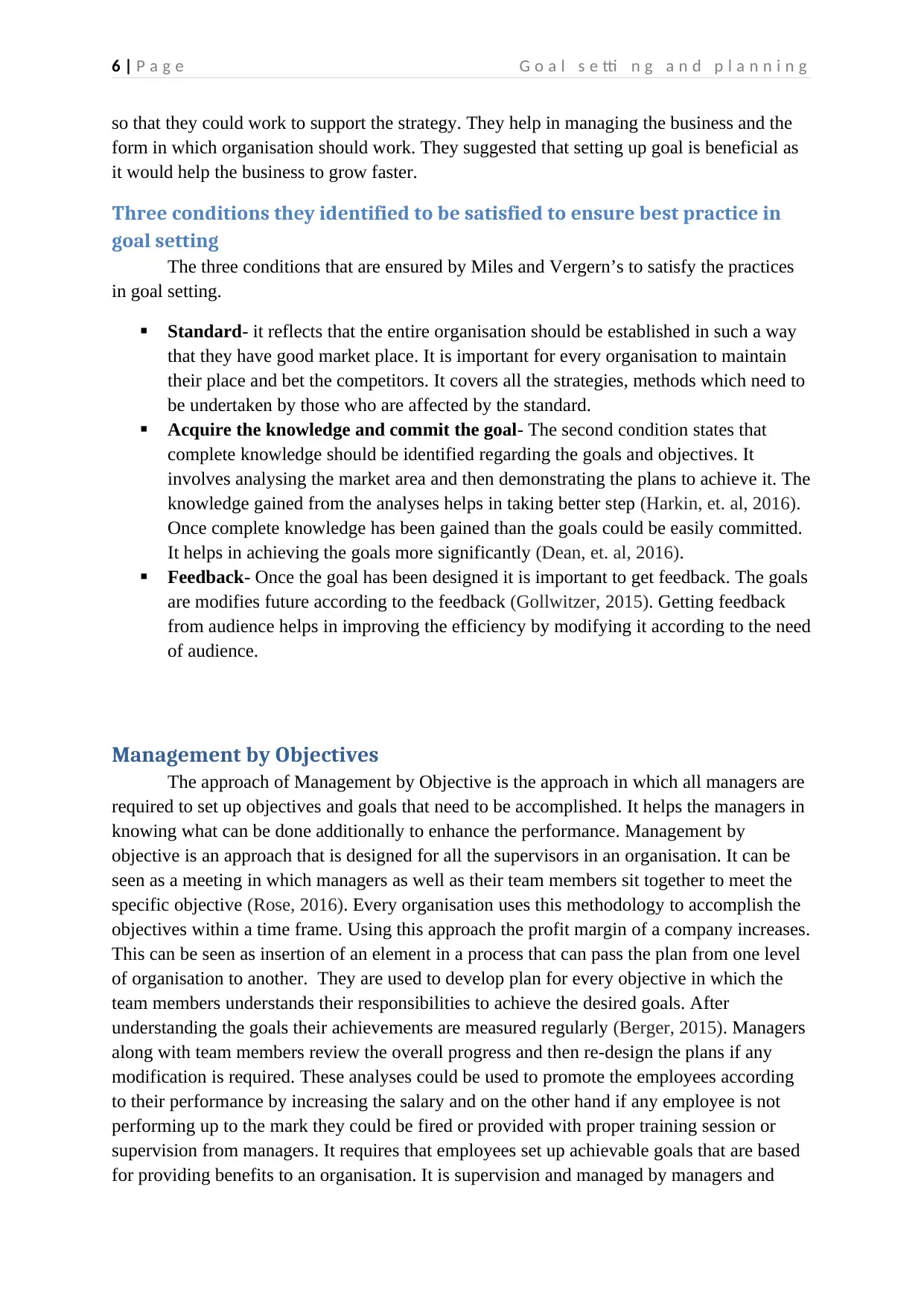
6 | P a g e G o a l s e tti n g a n d p l a n n i n g
so that they could work to support the strategy. They help in managing the business and the
form in which organisation should work. They suggested that setting up goal is beneficial as
it would help the business to grow faster.
Three conditions they identified to be satisfied to ensure best practice in
goal setting
The three conditions that are ensured by Miles and Vergern’s to satisfy the practices
in goal setting.
Standard- it reflects that the entire organisation should be established in such a way
that they have good market place. It is important for every organisation to maintain
their place and bet the competitors. It covers all the strategies, methods which need to
be undertaken by those who are affected by the standard.
Acquire the knowledge and commit the goal- The second condition states that
complete knowledge should be identified regarding the goals and objectives. It
involves analysing the market area and then demonstrating the plans to achieve it. The
knowledge gained from the analyses helps in taking better step (Harkin, et. al, 2016).
Once complete knowledge has been gained than the goals could be easily committed.
It helps in achieving the goals more significantly (Dean, et. al, 2016).
Feedback- Once the goal has been designed it is important to get feedback. The goals
are modifies future according to the feedback (Gollwitzer, 2015). Getting feedback
from audience helps in improving the efficiency by modifying it according to the need
of audience.
Management by Objectives
The approach of Management by Objective is the approach in which all managers are
required to set up objectives and goals that need to be accomplished. It helps the managers in
knowing what can be done additionally to enhance the performance. Management by
objective is an approach that is designed for all the supervisors in an organisation. It can be
seen as a meeting in which managers as well as their team members sit together to meet the
specific objective (Rose, 2016). Every organisation uses this methodology to accomplish the
objectives within a time frame. Using this approach the profit margin of a company increases.
This can be seen as insertion of an element in a process that can pass the plan from one level
of organisation to another. They are used to develop plan for every objective in which the
team members understands their responsibilities to achieve the desired goals. After
understanding the goals their achievements are measured regularly (Berger, 2015). Managers
along with team members review the overall progress and then re-design the plans if any
modification is required. These analyses could be used to promote the employees according
to their performance by increasing the salary and on the other hand if any employee is not
performing up to the mark they could be fired or provided with proper training session or
supervision from managers. It requires that employees set up achievable goals that are based
for providing benefits to an organisation. It is supervision and managed by managers and
so that they could work to support the strategy. They help in managing the business and the
form in which organisation should work. They suggested that setting up goal is beneficial as
it would help the business to grow faster.
Three conditions they identified to be satisfied to ensure best practice in
goal setting
The three conditions that are ensured by Miles and Vergern’s to satisfy the practices
in goal setting.
Standard- it reflects that the entire organisation should be established in such a way
that they have good market place. It is important for every organisation to maintain
their place and bet the competitors. It covers all the strategies, methods which need to
be undertaken by those who are affected by the standard.
Acquire the knowledge and commit the goal- The second condition states that
complete knowledge should be identified regarding the goals and objectives. It
involves analysing the market area and then demonstrating the plans to achieve it. The
knowledge gained from the analyses helps in taking better step (Harkin, et. al, 2016).
Once complete knowledge has been gained than the goals could be easily committed.
It helps in achieving the goals more significantly (Dean, et. al, 2016).
Feedback- Once the goal has been designed it is important to get feedback. The goals
are modifies future according to the feedback (Gollwitzer, 2015). Getting feedback
from audience helps in improving the efficiency by modifying it according to the need
of audience.
Management by Objectives
The approach of Management by Objective is the approach in which all managers are
required to set up objectives and goals that need to be accomplished. It helps the managers in
knowing what can be done additionally to enhance the performance. Management by
objective is an approach that is designed for all the supervisors in an organisation. It can be
seen as a meeting in which managers as well as their team members sit together to meet the
specific objective (Rose, 2016). Every organisation uses this methodology to accomplish the
objectives within a time frame. Using this approach the profit margin of a company increases.
This can be seen as insertion of an element in a process that can pass the plan from one level
of organisation to another. They are used to develop plan for every objective in which the
team members understands their responsibilities to achieve the desired goals. After
understanding the goals their achievements are measured regularly (Berger, 2015). Managers
along with team members review the overall progress and then re-design the plans if any
modification is required. These analyses could be used to promote the employees according
to their performance by increasing the salary and on the other hand if any employee is not
performing up to the mark they could be fired or provided with proper training session or
supervision from managers. It requires that employees set up achievable goals that are based
for providing benefits to an organisation. It is supervision and managed by managers and
Paraphrase This Document
Need a fresh take? Get an instant paraphrase of this document with our AI Paraphraser
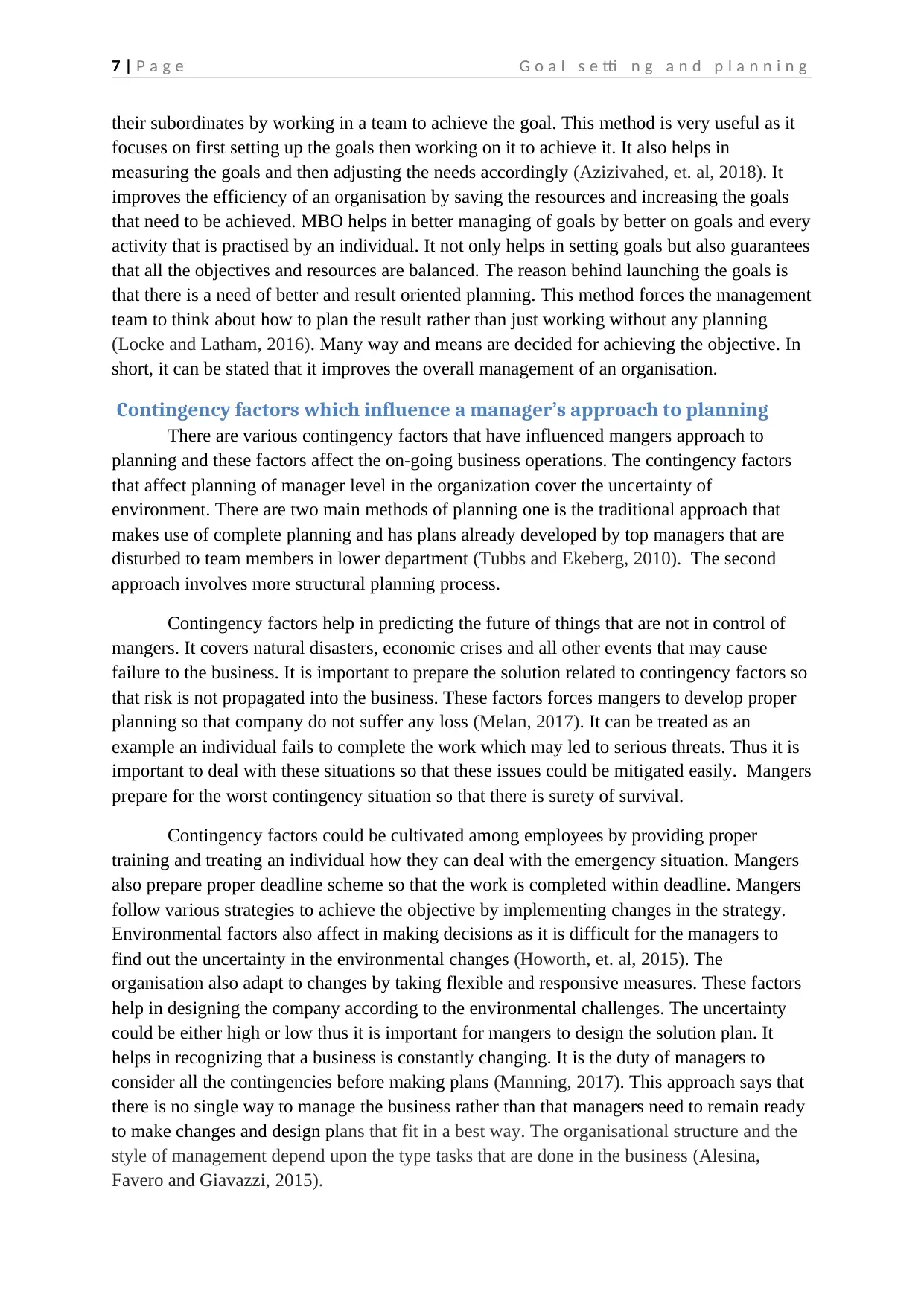
7 | P a g e G o a l s e tti n g a n d p l a n n i n g
their subordinates by working in a team to achieve the goal. This method is very useful as it
focuses on first setting up the goals then working on it to achieve it. It also helps in
measuring the goals and then adjusting the needs accordingly (Azizivahed, et. al, 2018). It
improves the efficiency of an organisation by saving the resources and increasing the goals
that need to be achieved. MBO helps in better managing of goals by better on goals and every
activity that is practised by an individual. It not only helps in setting goals but also guarantees
that all the objectives and resources are balanced. The reason behind launching the goals is
that there is a need of better and result oriented planning. This method forces the management
team to think about how to plan the result rather than just working without any planning
(Locke and Latham, 2016). Many way and means are decided for achieving the objective. In
short, it can be stated that it improves the overall management of an organisation.
Contingency factors which influence a manager’s approach to planning
There are various contingency factors that have influenced mangers approach to
planning and these factors affect the on-going business operations. The contingency factors
that affect planning of manager level in the organization cover the uncertainty of
environment. There are two main methods of planning one is the traditional approach that
makes use of complete planning and has plans already developed by top managers that are
disturbed to team members in lower department (Tubbs and Ekeberg, 2010). The second
approach involves more structural planning process.
Contingency factors help in predicting the future of things that are not in control of
mangers. It covers natural disasters, economic crises and all other events that may cause
failure to the business. It is important to prepare the solution related to contingency factors so
that risk is not propagated into the business. These factors forces mangers to develop proper
planning so that company do not suffer any loss (Melan, 2017). It can be treated as an
example an individual fails to complete the work which may led to serious threats. Thus it is
important to deal with these situations so that these issues could be mitigated easily. Mangers
prepare for the worst contingency situation so that there is surety of survival.
Contingency factors could be cultivated among employees by providing proper
training and treating an individual how they can deal with the emergency situation. Mangers
also prepare proper deadline scheme so that the work is completed within deadline. Mangers
follow various strategies to achieve the objective by implementing changes in the strategy.
Environmental factors also affect in making decisions as it is difficult for the managers to
find out the uncertainty in the environmental changes (Howorth, et. al, 2015). The
organisation also adapt to changes by taking flexible and responsive measures. These factors
help in designing the company according to the environmental challenges. The uncertainty
could be either high or low thus it is important for mangers to design the solution plan. It
helps in recognizing that a business is constantly changing. It is the duty of managers to
consider all the contingencies before making plans (Manning, 2017). This approach says that
there is no single way to manage the business rather than that managers need to remain ready
to make changes and design plans that fit in a best way. The organisational structure and the
style of management depend upon the type tasks that are done in the business (Alesina,
Favero and Giavazzi, 2015).
their subordinates by working in a team to achieve the goal. This method is very useful as it
focuses on first setting up the goals then working on it to achieve it. It also helps in
measuring the goals and then adjusting the needs accordingly (Azizivahed, et. al, 2018). It
improves the efficiency of an organisation by saving the resources and increasing the goals
that need to be achieved. MBO helps in better managing of goals by better on goals and every
activity that is practised by an individual. It not only helps in setting goals but also guarantees
that all the objectives and resources are balanced. The reason behind launching the goals is
that there is a need of better and result oriented planning. This method forces the management
team to think about how to plan the result rather than just working without any planning
(Locke and Latham, 2016). Many way and means are decided for achieving the objective. In
short, it can be stated that it improves the overall management of an organisation.
Contingency factors which influence a manager’s approach to planning
There are various contingency factors that have influenced mangers approach to
planning and these factors affect the on-going business operations. The contingency factors
that affect planning of manager level in the organization cover the uncertainty of
environment. There are two main methods of planning one is the traditional approach that
makes use of complete planning and has plans already developed by top managers that are
disturbed to team members in lower department (Tubbs and Ekeberg, 2010). The second
approach involves more structural planning process.
Contingency factors help in predicting the future of things that are not in control of
mangers. It covers natural disasters, economic crises and all other events that may cause
failure to the business. It is important to prepare the solution related to contingency factors so
that risk is not propagated into the business. These factors forces mangers to develop proper
planning so that company do not suffer any loss (Melan, 2017). It can be treated as an
example an individual fails to complete the work which may led to serious threats. Thus it is
important to deal with these situations so that these issues could be mitigated easily. Mangers
prepare for the worst contingency situation so that there is surety of survival.
Contingency factors could be cultivated among employees by providing proper
training and treating an individual how they can deal with the emergency situation. Mangers
also prepare proper deadline scheme so that the work is completed within deadline. Mangers
follow various strategies to achieve the objective by implementing changes in the strategy.
Environmental factors also affect in making decisions as it is difficult for the managers to
find out the uncertainty in the environmental changes (Howorth, et. al, 2015). The
organisation also adapt to changes by taking flexible and responsive measures. These factors
help in designing the company according to the environmental challenges. The uncertainty
could be either high or low thus it is important for mangers to design the solution plan. It
helps in recognizing that a business is constantly changing. It is the duty of managers to
consider all the contingencies before making plans (Manning, 2017). This approach says that
there is no single way to manage the business rather than that managers need to remain ready
to make changes and design plans that fit in a best way. The organisational structure and the
style of management depend upon the type tasks that are done in the business (Alesina,
Favero and Giavazzi, 2015).
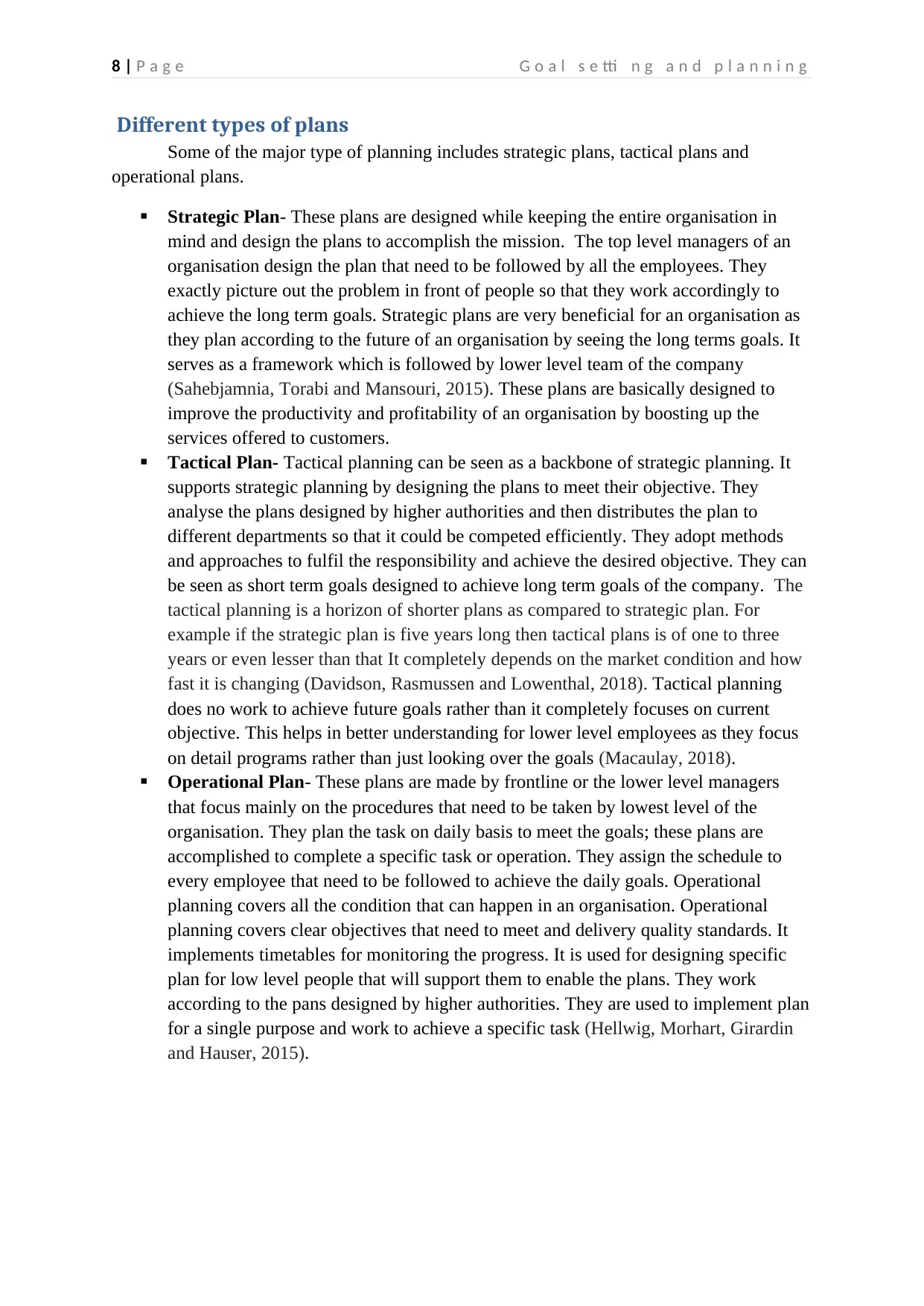
8 | P a g e G o a l s e tti n g a n d p l a n n i n g
Different types of plans
Some of the major type of planning includes strategic plans, tactical plans and
operational plans.
Strategic Plan- These plans are designed while keeping the entire organisation in
mind and design the plans to accomplish the mission. The top level managers of an
organisation design the plan that need to be followed by all the employees. They
exactly picture out the problem in front of people so that they work accordingly to
achieve the long term goals. Strategic plans are very beneficial for an organisation as
they plan according to the future of an organisation by seeing the long terms goals. It
serves as a framework which is followed by lower level team of the company
(Sahebjamnia, Torabi and Mansouri, 2015). These plans are basically designed to
improve the productivity and profitability of an organisation by boosting up the
services offered to customers.
Tactical Plan- Tactical planning can be seen as a backbone of strategic planning. It
supports strategic planning by designing the plans to meet their objective. They
analyse the plans designed by higher authorities and then distributes the plan to
different departments so that it could be competed efficiently. They adopt methods
and approaches to fulfil the responsibility and achieve the desired objective. They can
be seen as short term goals designed to achieve long term goals of the company. The
tactical planning is a horizon of shorter plans as compared to strategic plan. For
example if the strategic plan is five years long then tactical plans is of one to three
years or even lesser than that It completely depends on the market condition and how
fast it is changing (Davidson, Rasmussen and Lowenthal, 2018). Tactical planning
does no work to achieve future goals rather than it completely focuses on current
objective. This helps in better understanding for lower level employees as they focus
on detail programs rather than just looking over the goals (Macaulay, 2018).
Operational Plan- These plans are made by frontline or the lower level managers
that focus mainly on the procedures that need to be taken by lowest level of the
organisation. They plan the task on daily basis to meet the goals; these plans are
accomplished to complete a specific task or operation. They assign the schedule to
every employee that need to be followed to achieve the daily goals. Operational
planning covers all the condition that can happen in an organisation. Operational
planning covers clear objectives that need to meet and delivery quality standards. It
implements timetables for monitoring the progress. It is used for designing specific
plan for low level people that will support them to enable the plans. They work
according to the pans designed by higher authorities. They are used to implement plan
for a single purpose and work to achieve a specific task (Hellwig, Morhart, Girardin
and Hauser, 2015).
Different types of plans
Some of the major type of planning includes strategic plans, tactical plans and
operational plans.
Strategic Plan- These plans are designed while keeping the entire organisation in
mind and design the plans to accomplish the mission. The top level managers of an
organisation design the plan that need to be followed by all the employees. They
exactly picture out the problem in front of people so that they work accordingly to
achieve the long term goals. Strategic plans are very beneficial for an organisation as
they plan according to the future of an organisation by seeing the long terms goals. It
serves as a framework which is followed by lower level team of the company
(Sahebjamnia, Torabi and Mansouri, 2015). These plans are basically designed to
improve the productivity and profitability of an organisation by boosting up the
services offered to customers.
Tactical Plan- Tactical planning can be seen as a backbone of strategic planning. It
supports strategic planning by designing the plans to meet their objective. They
analyse the plans designed by higher authorities and then distributes the plan to
different departments so that it could be competed efficiently. They adopt methods
and approaches to fulfil the responsibility and achieve the desired objective. They can
be seen as short term goals designed to achieve long term goals of the company. The
tactical planning is a horizon of shorter plans as compared to strategic plan. For
example if the strategic plan is five years long then tactical plans is of one to three
years or even lesser than that It completely depends on the market condition and how
fast it is changing (Davidson, Rasmussen and Lowenthal, 2018). Tactical planning
does no work to achieve future goals rather than it completely focuses on current
objective. This helps in better understanding for lower level employees as they focus
on detail programs rather than just looking over the goals (Macaulay, 2018).
Operational Plan- These plans are made by frontline or the lower level managers
that focus mainly on the procedures that need to be taken by lowest level of the
organisation. They plan the task on daily basis to meet the goals; these plans are
accomplished to complete a specific task or operation. They assign the schedule to
every employee that need to be followed to achieve the daily goals. Operational
planning covers all the condition that can happen in an organisation. Operational
planning covers clear objectives that need to meet and delivery quality standards. It
implements timetables for monitoring the progress. It is used for designing specific
plan for low level people that will support them to enable the plans. They work
according to the pans designed by higher authorities. They are used to implement plan
for a single purpose and work to achieve a specific task (Hellwig, Morhart, Girardin
and Hauser, 2015).
⊘ This is a preview!⊘
Do you want full access?
Subscribe today to unlock all pages.

Trusted by 1+ million students worldwide
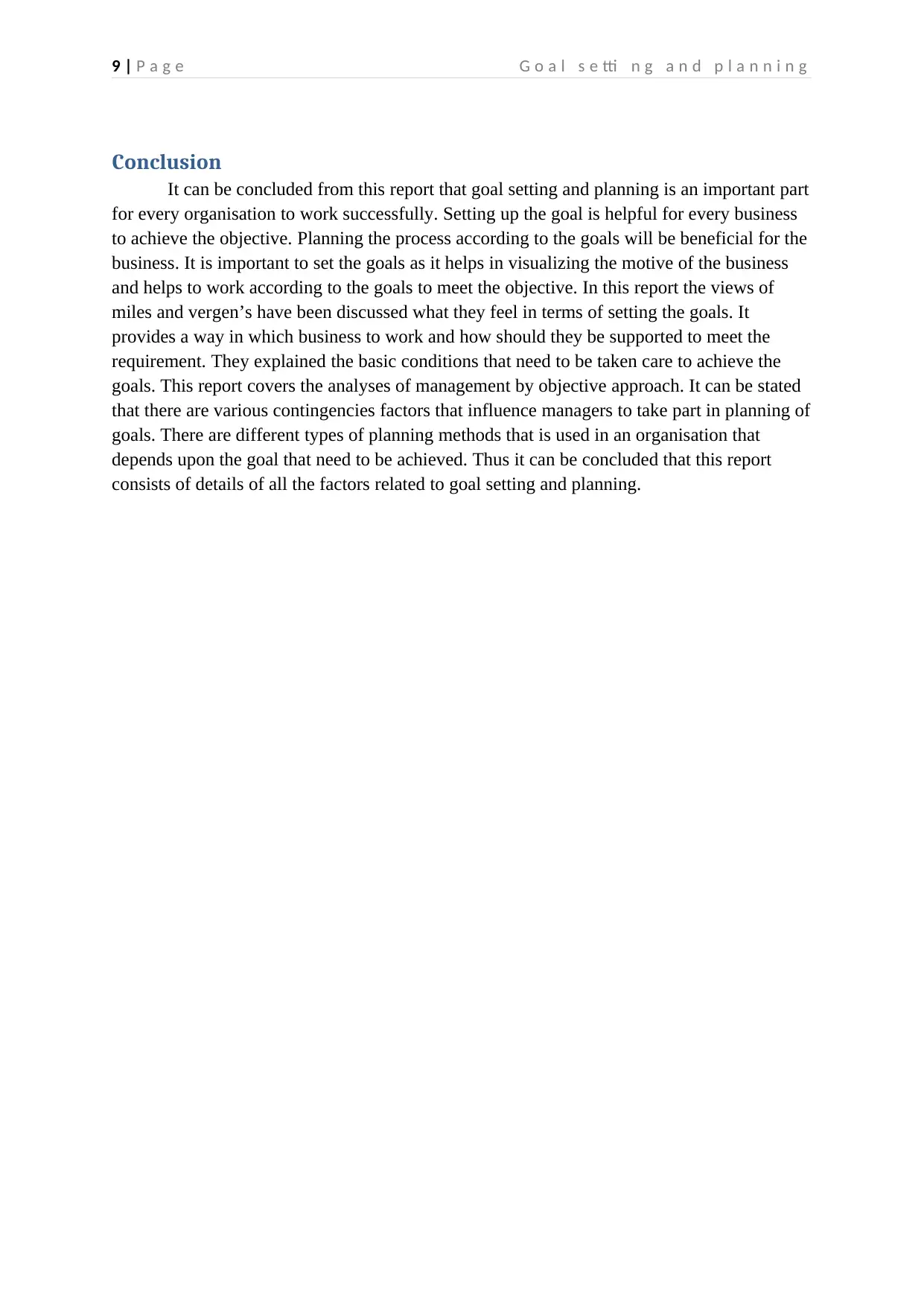
9 | P a g e G o a l s e tti n g a n d p l a n n i n g
Conclusion
It can be concluded from this report that goal setting and planning is an important part
for every organisation to work successfully. Setting up the goal is helpful for every business
to achieve the objective. Planning the process according to the goals will be beneficial for the
business. It is important to set the goals as it helps in visualizing the motive of the business
and helps to work according to the goals to meet the objective. In this report the views of
miles and vergen’s have been discussed what they feel in terms of setting the goals. It
provides a way in which business to work and how should they be supported to meet the
requirement. They explained the basic conditions that need to be taken care to achieve the
goals. This report covers the analyses of management by objective approach. It can be stated
that there are various contingencies factors that influence managers to take part in planning of
goals. There are different types of planning methods that is used in an organisation that
depends upon the goal that need to be achieved. Thus it can be concluded that this report
consists of details of all the factors related to goal setting and planning.
Conclusion
It can be concluded from this report that goal setting and planning is an important part
for every organisation to work successfully. Setting up the goal is helpful for every business
to achieve the objective. Planning the process according to the goals will be beneficial for the
business. It is important to set the goals as it helps in visualizing the motive of the business
and helps to work according to the goals to meet the objective. In this report the views of
miles and vergen’s have been discussed what they feel in terms of setting the goals. It
provides a way in which business to work and how should they be supported to meet the
requirement. They explained the basic conditions that need to be taken care to achieve the
goals. This report covers the analyses of management by objective approach. It can be stated
that there are various contingencies factors that influence managers to take part in planning of
goals. There are different types of planning methods that is used in an organisation that
depends upon the goal that need to be achieved. Thus it can be concluded that this report
consists of details of all the factors related to goal setting and planning.
Paraphrase This Document
Need a fresh take? Get an instant paraphrase of this document with our AI Paraphraser
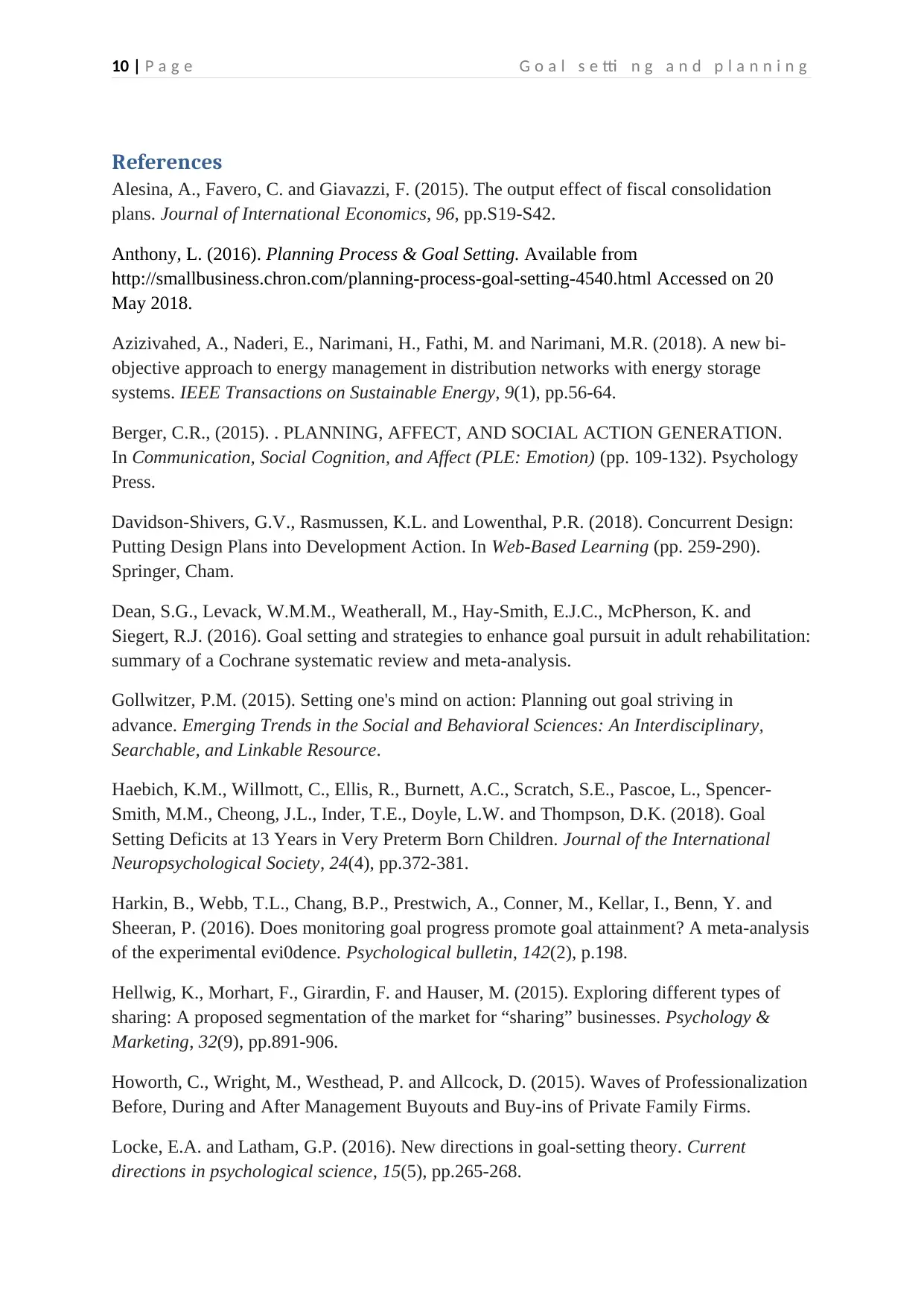
10 | P a g e G o a l s e tti n g a n d p l a n n i n g
References
Alesina, A., Favero, C. and Giavazzi, F. (2015). The output effect of fiscal consolidation
plans. Journal of International Economics, 96, pp.S19-S42.
Anthony, L. (2016). Planning Process & Goal Setting. Available from
http://smallbusiness.chron.com/planning-process-goal-setting-4540.html Accessed on 20
May 2018.
Azizivahed, A., Naderi, E., Narimani, H., Fathi, M. and Narimani, M.R. (2018). A new bi-
objective approach to energy management in distribution networks with energy storage
systems. IEEE Transactions on Sustainable Energy, 9(1), pp.56-64.
Berger, C.R., (2015). . PLANNING, AFFECT, AND SOCIAL ACTION GENERATION.
In Communication, Social Cognition, and Affect (PLE: Emotion) (pp. 109-132). Psychology
Press.
Davidson-Shivers, G.V., Rasmussen, K.L. and Lowenthal, P.R. (2018). Concurrent Design:
Putting Design Plans into Development Action. In Web-Based Learning (pp. 259-290).
Springer, Cham.
Dean, S.G., Levack, W.M.M., Weatherall, M., Hay-Smith, E.J.C., McPherson, K. and
Siegert, R.J. (2016). Goal setting and strategies to enhance goal pursuit in adult rehabilitation:
summary of a Cochrane systematic review and meta-analysis.
Gollwitzer, P.M. (2015). Setting one's mind on action: Planning out goal striving in
advance. Emerging Trends in the Social and Behavioral Sciences: An Interdisciplinary,
Searchable, and Linkable Resource.
Haebich, K.M., Willmott, C., Ellis, R., Burnett, A.C., Scratch, S.E., Pascoe, L., Spencer-
Smith, M.M., Cheong, J.L., Inder, T.E., Doyle, L.W. and Thompson, D.K. (2018). Goal
Setting Deficits at 13 Years in Very Preterm Born Children. Journal of the International
Neuropsychological Society, 24(4), pp.372-381.
Harkin, B., Webb, T.L., Chang, B.P., Prestwich, A., Conner, M., Kellar, I., Benn, Y. and
Sheeran, P. (2016). Does monitoring goal progress promote goal attainment? A meta-analysis
of the experimental evi0dence. Psychological bulletin, 142(2), p.198.
Hellwig, K., Morhart, F., Girardin, F. and Hauser, M. (2015). Exploring different types of
sharing: A proposed segmentation of the market for “sharing” businesses. Psychology &
Marketing, 32(9), pp.891-906.
Howorth, C., Wright, M., Westhead, P. and Allcock, D. (2015). Waves of Professionalization
Before, During and After Management Buyouts and Buy-ins of Private Family Firms.
Locke, E.A. and Latham, G.P. (2016). New directions in goal-setting theory. Current
directions in psychological science, 15(5), pp.265-268.
References
Alesina, A., Favero, C. and Giavazzi, F. (2015). The output effect of fiscal consolidation
plans. Journal of International Economics, 96, pp.S19-S42.
Anthony, L. (2016). Planning Process & Goal Setting. Available from
http://smallbusiness.chron.com/planning-process-goal-setting-4540.html Accessed on 20
May 2018.
Azizivahed, A., Naderi, E., Narimani, H., Fathi, M. and Narimani, M.R. (2018). A new bi-
objective approach to energy management in distribution networks with energy storage
systems. IEEE Transactions on Sustainable Energy, 9(1), pp.56-64.
Berger, C.R., (2015). . PLANNING, AFFECT, AND SOCIAL ACTION GENERATION.
In Communication, Social Cognition, and Affect (PLE: Emotion) (pp. 109-132). Psychology
Press.
Davidson-Shivers, G.V., Rasmussen, K.L. and Lowenthal, P.R. (2018). Concurrent Design:
Putting Design Plans into Development Action. In Web-Based Learning (pp. 259-290).
Springer, Cham.
Dean, S.G., Levack, W.M.M., Weatherall, M., Hay-Smith, E.J.C., McPherson, K. and
Siegert, R.J. (2016). Goal setting and strategies to enhance goal pursuit in adult rehabilitation:
summary of a Cochrane systematic review and meta-analysis.
Gollwitzer, P.M. (2015). Setting one's mind on action: Planning out goal striving in
advance. Emerging Trends in the Social and Behavioral Sciences: An Interdisciplinary,
Searchable, and Linkable Resource.
Haebich, K.M., Willmott, C., Ellis, R., Burnett, A.C., Scratch, S.E., Pascoe, L., Spencer-
Smith, M.M., Cheong, J.L., Inder, T.E., Doyle, L.W. and Thompson, D.K. (2018). Goal
Setting Deficits at 13 Years in Very Preterm Born Children. Journal of the International
Neuropsychological Society, 24(4), pp.372-381.
Harkin, B., Webb, T.L., Chang, B.P., Prestwich, A., Conner, M., Kellar, I., Benn, Y. and
Sheeran, P. (2016). Does monitoring goal progress promote goal attainment? A meta-analysis
of the experimental evi0dence. Psychological bulletin, 142(2), p.198.
Hellwig, K., Morhart, F., Girardin, F. and Hauser, M. (2015). Exploring different types of
sharing: A proposed segmentation of the market for “sharing” businesses. Psychology &
Marketing, 32(9), pp.891-906.
Howorth, C., Wright, M., Westhead, P. and Allcock, D. (2015). Waves of Professionalization
Before, During and After Management Buyouts and Buy-ins of Private Family Firms.
Locke, E.A. and Latham, G.P. (2016). New directions in goal-setting theory. Current
directions in psychological science, 15(5), pp.265-268.
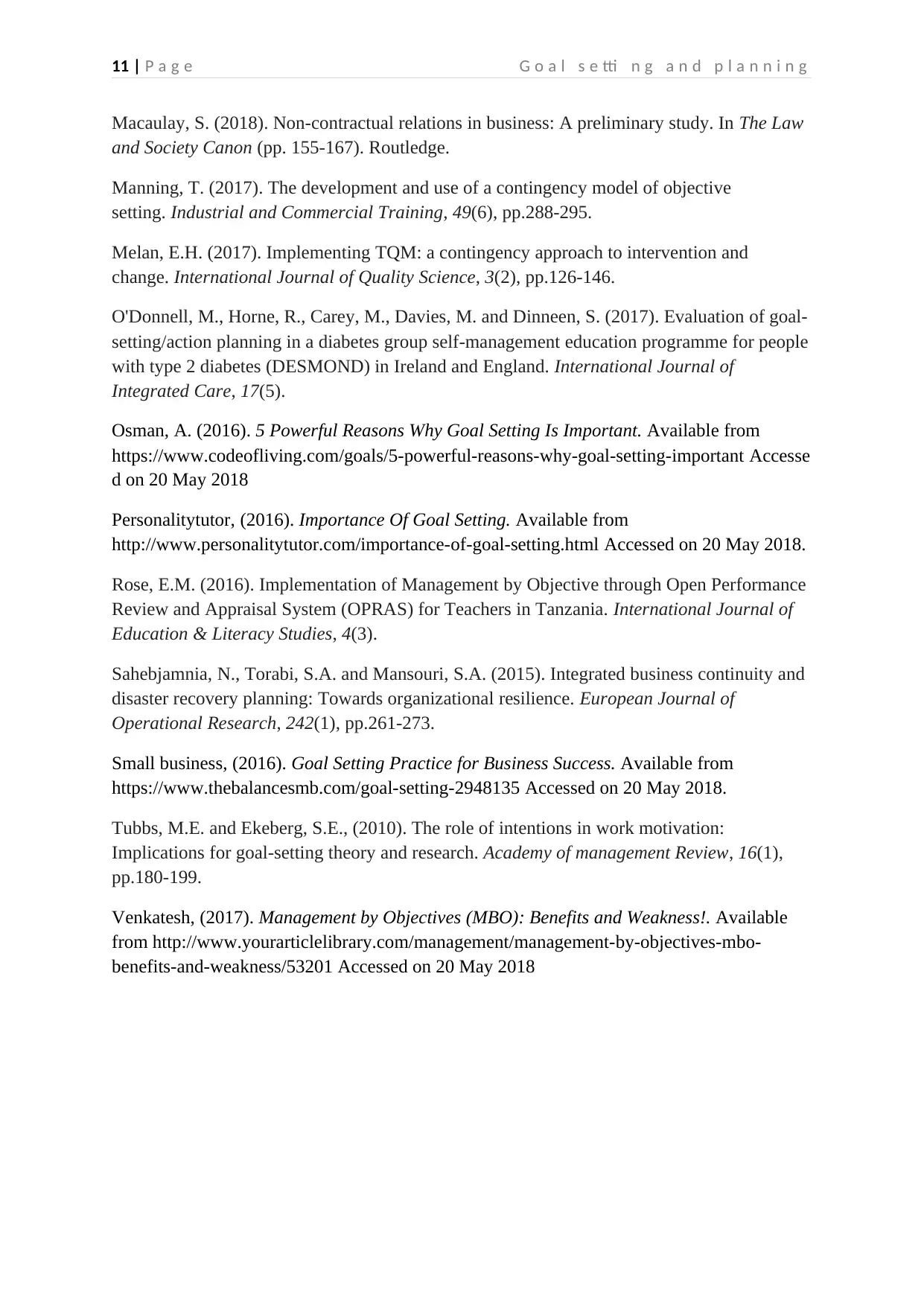
11 | P a g e G o a l s e tti n g a n d p l a n n i n g
Macaulay, S. (2018). Non-contractual relations in business: A preliminary study. In The Law
and Society Canon (pp. 155-167). Routledge.
Manning, T. (2017). The development and use of a contingency model of objective
setting. Industrial and Commercial Training, 49(6), pp.288-295.
Melan, E.H. (2017). Implementing TQM: a contingency approach to intervention and
change. International Journal of Quality Science, 3(2), pp.126-146.
O'Donnell, M., Horne, R., Carey, M., Davies, M. and Dinneen, S. (2017). Evaluation of goal-
setting/action planning in a diabetes group self-management education programme for people
with type 2 diabetes (DESMOND) in Ireland and England. International Journal of
Integrated Care, 17(5).
Osman, A. (2016). 5 Powerful Reasons Why Goal Setting Is Important. Available from
https://www.codeofliving.com/goals/5-powerful-reasons-why-goal-setting-important Accesse
d on 20 May 2018
Personalitytutor, (2016). Importance Of Goal Setting. Available from
http://www.personalitytutor.com/importance-of-goal-setting.html Accessed on 20 May 2018.
Rose, E.M. (2016). Implementation of Management by Objective through Open Performance
Review and Appraisal System (OPRAS) for Teachers in Tanzania. International Journal of
Education & Literacy Studies, 4(3).
Sahebjamnia, N., Torabi, S.A. and Mansouri, S.A. (2015). Integrated business continuity and
disaster recovery planning: Towards organizational resilience. European Journal of
Operational Research, 242(1), pp.261-273.
Small business, (2016). Goal Setting Practice for Business Success. Available from
https://www.thebalancesmb.com/goal-setting-2948135 Accessed on 20 May 2018.
Tubbs, M.E. and Ekeberg, S.E., (2010). The role of intentions in work motivation:
Implications for goal-setting theory and research. Academy of management Review, 16(1),
pp.180-199.
Venkatesh, (2017). Management by Objectives (MBO): Benefits and Weakness!. Available
from http://www.yourarticlelibrary.com/management/management-by-objectives-mbo-
benefits-and-weakness/53201 Accessed on 20 May 2018
Macaulay, S. (2018). Non-contractual relations in business: A preliminary study. In The Law
and Society Canon (pp. 155-167). Routledge.
Manning, T. (2017). The development and use of a contingency model of objective
setting. Industrial and Commercial Training, 49(6), pp.288-295.
Melan, E.H. (2017). Implementing TQM: a contingency approach to intervention and
change. International Journal of Quality Science, 3(2), pp.126-146.
O'Donnell, M., Horne, R., Carey, M., Davies, M. and Dinneen, S. (2017). Evaluation of goal-
setting/action planning in a diabetes group self-management education programme for people
with type 2 diabetes (DESMOND) in Ireland and England. International Journal of
Integrated Care, 17(5).
Osman, A. (2016). 5 Powerful Reasons Why Goal Setting Is Important. Available from
https://www.codeofliving.com/goals/5-powerful-reasons-why-goal-setting-important Accesse
d on 20 May 2018
Personalitytutor, (2016). Importance Of Goal Setting. Available from
http://www.personalitytutor.com/importance-of-goal-setting.html Accessed on 20 May 2018.
Rose, E.M. (2016). Implementation of Management by Objective through Open Performance
Review and Appraisal System (OPRAS) for Teachers in Tanzania. International Journal of
Education & Literacy Studies, 4(3).
Sahebjamnia, N., Torabi, S.A. and Mansouri, S.A. (2015). Integrated business continuity and
disaster recovery planning: Towards organizational resilience. European Journal of
Operational Research, 242(1), pp.261-273.
Small business, (2016). Goal Setting Practice for Business Success. Available from
https://www.thebalancesmb.com/goal-setting-2948135 Accessed on 20 May 2018.
Tubbs, M.E. and Ekeberg, S.E., (2010). The role of intentions in work motivation:
Implications for goal-setting theory and research. Academy of management Review, 16(1),
pp.180-199.
Venkatesh, (2017). Management by Objectives (MBO): Benefits and Weakness!. Available
from http://www.yourarticlelibrary.com/management/management-by-objectives-mbo-
benefits-and-weakness/53201 Accessed on 20 May 2018
⊘ This is a preview!⊘
Do you want full access?
Subscribe today to unlock all pages.

Trusted by 1+ million students worldwide
1 out of 12
Related Documents
Your All-in-One AI-Powered Toolkit for Academic Success.
+13062052269
info@desklib.com
Available 24*7 on WhatsApp / Email
![[object Object]](/_next/static/media/star-bottom.7253800d.svg)
Unlock your academic potential
Copyright © 2020–2025 A2Z Services. All Rights Reserved. Developed and managed by ZUCOL.



